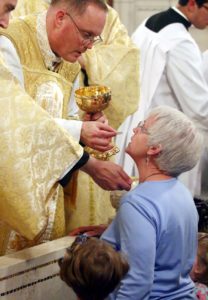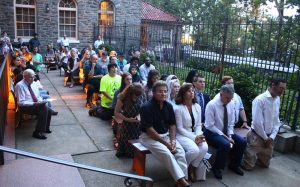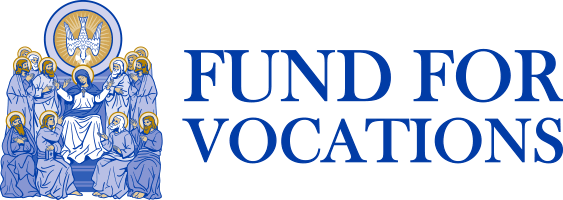This past July 25 marked the one-year anniversary of the re-foundation of the Carmelite Monastery of St. Joseph and St. Anne in downtown Philadelphia. Founded in 1902, the monastery was a thriving community and an important hub of Catholic life in Philadephia before going into decline starting in the late 1960s. By 2017, the Philadelphia Carmel was down to just five members. The story of its renewal is a source of great hope. It also illustrates the ripple effect of support to the Mater Ecclesiae Fund for Vocations. One of the 10 nuns sent to Philadelphia to help renew that community is Sister Mary Magdalene, née Channing Dale, a 2013 grant recipient who was able to enter formation at the Carmel of Elysburg (Pennsylvania) thanks to the MEFV’s supporters’ generosity.
One of the five sisters who remained with the Philadelphia Carmel and helped incorporate the 10 new members into that community offered these reflections in September 2018. In keeping with the Carmelite charism, she does not wish to be named.
We knew of course that we had to do something. Our community had dwindled to five members, none of us particularly young. I myself am 78 years old now, and I entered the Philadelphia Carmel 55 years ago. I can truly say that my vocation has been a gift from Heaven. But beginning with the (Second Vatican) council, vocations declined, and you cannot run this place with just five people.
The good news is, the Carmelite order in general has been thriving. We’re building a new monastery in Fairfield (Pennsylvania) and some of the sisters with responsibility for founding that new location came to our Carmel, initially just to see the architecture, for inspiration. We feel it’s important for monastic architecture to respect tradition, and the Philadelphia Carmel is a beautiful example. The visiting sisters were very gracious, and the idea just naturally came up: What if some of you came here, to renew this existing community? I went with one of the other nuns to Elysburg, to meet with the prioress of that community and start exploring the idea seriously. The upshot was, provided that the Valparaiso (Nebraska) Carmelites were also willing, Elysburg was in! (The Elysburg Carmel was itself founded by nuns from Valparaiso.) It was such a hopeful turn of events. So then I went out to Valparaiso to explore the idea with them, too, and it all just kind of came together.
There is no question that the renewal of our community has been the work of the Holy Spirit. You could feel that presence on the evening of the Solemn High Mass (July 26, 2017) to celebrate the re-foundation of our community. It was a boiling hot summer night, but more than 400 people turned up—the overflow had to sit outside and watch the Mass on monitors. We were of course behind the grille, but after Mass the bishop requested that we go to the speak room and receive everyone. It was just glorious. But the Holy Spirit was at work in other ways too. For example, the Valparaiso sisters booked their travel from Nebraska to Philadelphia for July 25 without realizing that the date of our founding had been . . . July 25. So the new sisters for the re-foundation arrived 115 years to the day from the date of our original founding. Some “coincidence!”

Father Scott W. Allen, F.S.S.P., distributes holy Communion to faithful at the altar rail in the chapel of the Carmelite Monastery July 26, 2017.
The local people regularly come now to Mass at the monastery and sometimes also for the praying of the Liturgy of the Hours. Most of them cannot follow along; they don’t necessarily understand the Latin well enough, or own a Latin breviary. But you know, beauty attracts. Even if they cannot fully participate or follow along, their souls respond to the power and the beauty of the Latin Mass and daily offices.
The Latin Mass was in fact one of the adjustments of merging our communities. It was very important to the nuns from Valparaiso and Elysburg. (Of the 10 new nuns, six were from Valparaiso and four, including MEFV grantee Sister Mary Magdalene, were from Elysburg. Ed.) The younger sisters are passionately committed to traditional Carmelite customs: wearing the habit, cloistered contemplation, studying the great saints of our Order, ancient chant modes, and the Latin Mass. They are not opposed to the ordinary form, if a particular celebrant wants to offer the Mass that way, but the Latin Mass is deeply important to them. That was an adjustment for the original five of us, but not the only one. Every Carmel, like any and every other family, has its own little ways and idiosyncrasies. So in some ways, on the natural level, the re-foundation of our monastery involved the merging of three families.

Faithful who could not fit inside the chapel worshiped instead in a courtyard outside, aided by the video on a large television screen.
The new sisters are much younger too, of course, in their 20s and 30s. That is another truly beautiful thing, to see such a renewal of strong Catholic family life in this generation. For the generations who came of age starting in the 1970s, the idea of consecrated life, especially as a cloistered contemplative, was something completely bizarre. But for these girls, who grew up with their parents reading things like The Story of a Soul to them, it’s completely normal. They are from big Catholic families. Most of them were home-schooled; many of them also have at least one other sibling in formation for the priesthood or consecrated life. Their parents deliberately chose places like Omaha or Kansas where they could live out unapologetically authentic Catholic lives and it shows so clearly in the way they raised their children. The new sisters here are very, very intelligent, well educated, and talented. They play the violin, read and write poetry, put on plays, read and study seriously. They are a joy to us, and a blessing to Philadelphia and beyond.
I am the only one left now of the original five of us who were here when the Elysburg and Valparaiso sisters arrived last year. We have suffered some deaths and one sister, who had been here “on loan” from a different Carmel, received permission to go back home. God willing, more and more new vocations will continue to join the 10 who came to our Carmel last year.
Please know how grateful all of us are for the Mater Ecclesiae Fund for Vocations—for its role in making it possible for Sister Mary Magdalene to accept her own call, for the many Carmelite vocations you have supported over the years, and for everything your work does to support the constant renewal of Christ’s church. May God continue to bless your work and ours!
